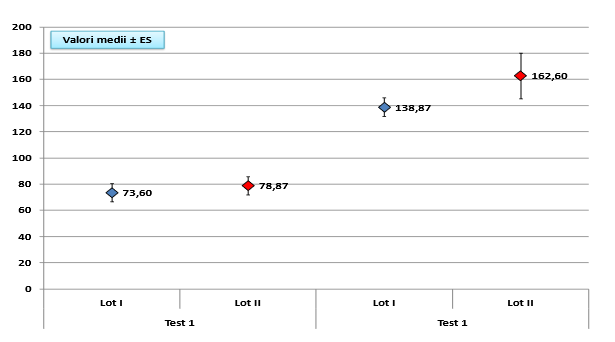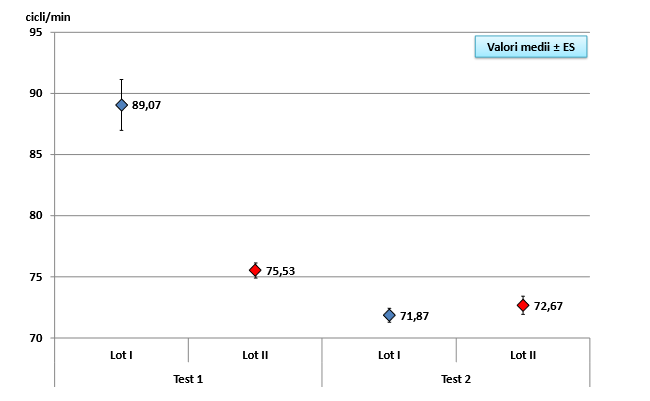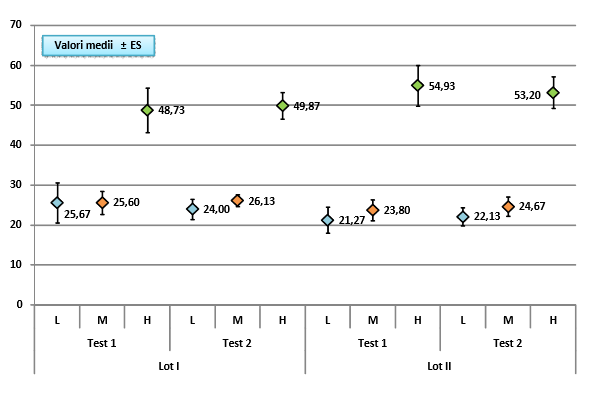Abstract
Purpose of study: The purpose of this study is to optimize the performance of athletes in biathlon skiing by creating a good overall self-confidence in both training and competitions. We need to identify a certain technique that will reduce stress and increase sport, mainly by using psychological training techniques. The main objective of the research is to measure the values of some physiological indicators as a result of mental formation through the technique of coherence and the combined technique of psycho physiological regulation. Methods: We have used the EmWave2 (like an ECG) that helps to optimize the rhythm. Physiological consistency is indicated by the device through three levels of correlation indicated by 3 colors: low (red), medium (blue), high (green). Findings and Conclusions: the EmWave2 The statistical results showed that the state of consistency was established following the use of the EmWave2 device and the neurophysiologic combination technique.
Keywords: Sport performanceEmWave2mental trainingbiathlon skiingexercise
Introduction
Personal experience has made us question about the lack of resistance, career speaking to some sportsmen, long term thinking.
We are wondering why some athletes manage to achieve and sustain high performances, and other athletes do not. Stress and anxiety before and during the competition raises problems that can lead to a real failure, despite the efforts and psychological training before the competition, as shown by (Biddle, 1995; Weinberg & Gould, 2011). It is important to know the factors that predispose and influence the psychological mechanisms in order to keep them under control so that we can optimize performance.
Besides the individual component, the performance has an enhanced social dimension, the appreciation of the value being shared, appreciated and validated socially (Iluţ, 2004; Spielberger, 2004). Recent theories and studies have brought spectacular developments in combining perspectives and techniques in sports physiology, sports science, sports psychology, sociology, and so on. The pyramid defined by Danish, (2001), refers to the things that embrace and influences peak performance.
Problem Statement
Specialized literature deals extensively with emotions in activities that involve effort, concentration, and performance stakes, which is obvious for athletes (Lazarus, 2000; O'Connor, 2005). Many times, emotions escape conscious from control and become sources of dysfunctions in doing activities.
In the preparation phase of the competition, various emotional manifestations may occur: loss of concentration, loss of clarity in thought and expression, lack of attention to the technician or coach's suggestions, loss of technique or tactical strategy, physiological reactions (pallor, clamping, sweating, digestive disorders, apathy, hyper excitation or irritability, etc.) (Bergland, 2015; Robinson, 2017). It is obvious, therefore, that strong emotion affects cognition, relationship to the context and control of one's own states, occurring errors of perception and coordination, mistakes in motion and tactics, thus installing the tract. That is why it is so important to know the mechanisms that once installed will interfere with the performance and balance of the athletes, and then treat them with specific methods, mental training and mind-body coordination (Robinson, 2017).
The motivation for choosing this theme was to develop an intervention strategy to reduce stress and competitive anxiety (Grosu, Motică, Ordean, & Grosu, 2018) through psychological training techniques by finding new effective methods and techniques in biathlon skiing. We believe that by testing these techniques we can bring valuable added value in the field of sports psychology. Psychological training methods have been constructed as their own techniques by applying to the athletes performance before and after the competition
Our own research was built on the principles of causality, compared to other articles. Thus, the mental training through coherence technique and the combined technique of psychophysiological regulation was the independent variable, and stress, anxiety, self-esteem and motivational persistence - dependent variables on which we followed the effect of mental training techniques on the experimental group, comparing the results obtained by applying standard tests and measurements for the two batches.
Research Questions
We wanted to know if by applying the coherence and the combined psycho physiological regulation on biathlon skiers we will obtain statistically significant effects.
Purpose of the Study
This particular and complex sport has lead us to think about the possibility of building a harmonious and coherent connection between the long-term psychosocial resistance of biathlon skiers and the practice of biathlon skiing.
By testing the stress and anxiety levels, we can assess whether mental formation through coherence technique and combined technique of psycho physiological regulation has statistically significant effects on biathlon skiers. Optimizing the mental formation by the coherence technique and combined psycho physiological adjustment is a strategy that we want to establish.
Organizing and conducting the research
The research took place between February 2015 and February 2016. We have applied the established tools as well as some ways to reduce the stress, personally built, the latter being addressed to the subjects of the experimental group, for the initial and final testing.
The control lot (I) consisted of 15 biathlon skiers, Vatra Dornei School Sports Club. They did not participate in this constant application program of the EmWave2 technique,
The experimental lot (II) consisted of 15 athletes, biathlon skiing section, the Baia Sprie – Sportive Club. The experimental lot was subject to rapid technique of achieving coherence and combined psycho physiological regulation technique (6 times during one year).
To the athletes from the experimental group were given initial and final tests for measurements, such as: attention, coordination and response speeds, self-esteem and motivational persistence as well as stress and anxiety.
Statistical indicators
The statistical processing was performed with the StatsDirect v.2.7.2 program and the Excel application (from the Microsoft Office 2010 package). The graphical representation of the results was done with the Excel application (from the Microsoft Office 2010 package). Statistical analysis: Shapiro-Wilk test, T test for normal distribution testing, non-parametric Mann-Whitney (U) tests for two non-paired samples, Wilcoxon - for two non-uniform distribution values; ANOVA test for normal distribution data or Kruskal-Wallis nonparametric test - for non-uniform distribution values or ranges for analysis of three or more samples.
Research Methods
The mental training techniques represent our applicative contribution to the psycho physiological training methodology, expressed by reducing the stress and anxiety
In this study, we want to contribute to the improvement of mental training techniques: the cohesive technique proposed by the HeartMath Institute with the EmWave device and the combined psycho physiological adjustment technique to alpine skiers. We have used mental training techniques, which were the independent variable, assuming that the results of psycho physiological tests and measurements will be different after applying the intervention program. These methods of reducing stress and anxiety are our contribution to knowledge in the field of sports psychology, an applicative contribution.
EmWave2, as an ECG, helps us to optimize heart rate to create a physiological coherence throughout the body with three levels of consistency (low, medium, high) highlighted by the colors: red, blue and green. The authors (McCraty, Atkinson, Tomasino, & Bradley, 2009; McCraty & Zayas, 2014) have shown that this technique can rapidly bring the heart rate to the state of consistency. Combined programs used to measure consistency and to achieve consistency to reduce overall stress by specific relaxation techniques are EmWave2 composed of: EmWave Desktop and EmWave Personal Stress Reliever.
The intervention program
The intervention program consisted in achieving the technique of coherence through the following stages: focus on the heart, breathing of the heart, "feeling with the heart". While maintaining the focus on the heart area and breathing, a positive feeling is activated. It is preferable to apply this technique in the morning, before training or contests, before a physical activity, or shooting technique. Methods of managing stress on different areas of mental activation are: physical relaxation, mental imagery and setting goals (Bergland, 2015; Brown, 2015,;Inner, 2017; Morton, 2017).
Findings
We have interpreted and compared the results in the two lots, by analyzing, discussing and verifying the validation of the proposed psychological training techniques during the investigation. In the EmWave2 test, we can see positive effects of the coherence technique combined with the psycho-physiological technique, manifested in psychological balance and stress management on both batches even if to the control group these techniques were applied only once. However, the effects on the experimental group are visible (differences between the scores and the level of coherence with statistical significance). These results can be interpreted through the multidimensional theory of anxiety (Goldin & Gross, 2100). (see table
Comparing the lots we can see that the level of consistency in the experimental group has higher "high" levels, and that the distribution of these values is more restricted (the experimental group seems to be more evenly in comparison with the control group). The statistical analysis of mean heart rate values produced a statistically significant difference between the two groups (p <0.001): for group I, we have a mean heart rate (median value of 91 cycles/minute) higher than in group II (with a median of 76 cycles/minute), the experimental group being more balanced on this indicator.
The effects on the experimental group are highly significant; the experimental group had a coherence score of 162.60, while those in the control group only 138.87. The difference is due to the interaction programs performed with the athletes using the technique measured with EmWave2. (see figure no
In EmWave2 test, correlating the values of score and medium cardiac frequency we have found in first lot an acceptable and same sense correlation between the two indicators; in the second lot a lack of correlation. Considering the relation between the coherence rate established by EmWave model and medium cardiac frequency, the subjects in the first lot have more modest results compared to the ones in the second lot, the difference being not significant.
To achieve consistency, those in lot II had a much lower average time distribution, indicating a more homogeneous profile of the experimental group versus the control group, indicating a positive effect of the mental training techniques applied regularly for a year, on the speed at which most athletes worked, they manage to relax.
In table
It can be observed, compared to the first test, that the differences in the level of consistency, for each lot, are higher ("significantly significant" versus "very significant" in group I one year ago, in the experimental group these differences remain "highly significant"). These results call for reflection: it seems that the simple test in the control group had a visible effect, without realizing the specific EmWave mental training. The experimental lot has a more solid outsole in this case, indicating a consistent effect of the coherence technique.

By comparing the batch results we can see the effectiveness of repeated application to each group, illustrated by average cardiac frequency. (see figure no

Analyzing the level of consistency (low, medium, high), the experimental lot obtained a visually higher value than the control group: 53.20 compared to 49, 87. ( see figure no

However, it is normal for some differences to occur, even if they did not intervene experimentally, given some natural conditions that intervene (equivalent batches, but more homogeneous athletes in terms of coherence indicators for lot II).A similar interpretation is also for the "duration of the test" variable, the coherence being reached by the athletes in the experimental group much more homogeneous (as a median value) compared to the athletes in the control group, although the actual time (the average number of minutes) is almost identical for the two tested groups.
Discussions
The desire to win is associated with stimulating emotions, increased confidence and psycho-physical resources involved in this approach, overcoming the previously estimated physical barriers where a series of neurotransmitters and hormones (dopamine, adrenaline) are activated, a phenomenon also called "sporting fury" (Lazarus, 2000; McCraty & Tomasino, 2009)
When a coherent pattern of cardiac rhythm appears, physiologically it can be said that the subject is in an optimal state of efficiency, so that not only it feels better but it also feels a well-being state in all parameters: physical, emotional and mental. Coherence is not the same as being in a relaxed state; rather it is what athletes call the area of performance.
Researches have shown that stress and emotions of all kinds are reflected in our heart rate pattern. This is because what we feel causes changes in activity in our nervous system that affect the pattern of heart rate. This pattern is transmitted from the heart to the upper brain centers and influences how the brain processes the information. Feelings of frustration and anxiety determine the heart rate to become more disordered and irregular, inhibiting the superior ability of the brain to function and causing a leak of energy. On the other hand, feelings of love and appreciation generate a constant heart rate model that promotes the superior functioning of the central brain, increasing discernment in problem solving and refreshing memory. Positive emotions produce more orderly and coherent heart rhythms that reduce nervous system imbalance due to stress and facilitate cortical function (McCraty et al., 2014).
Conclusion
By applying the Emwave test in the two lots we have found the followings: from the comparison of batches, it results that the level of consistency in the experimental group has higher "high" levels, and that the distribution of these values is narrower (the lot looks more uniform after the high level, compared to the control group); the statistical analysis of the score values did not indicate statistically significant differences between the two groups (p> 0.05), initial testing therefore starts from an equal level of the batches, according to the average values of the scores and the EmWave levels. The final testing indicates a positive effect, after applying a mental training technique during one year, most of the subjects being able to relax.
The subjects in the experimental group were able to better manage their emotional responses and increased their level of coherence by using the Coherence Coach. Even though the control group was not regularly subjected to combined neurophysiologic control technique, the analysis of the EmWave2 test values showed positive effects in state coherence.
The specialists who work in the field of sport (technicians, coaches, researchers, sports sociologists, sports psychologists) systematically outlined the idea that sport science requires an interdisciplinary approach (Gill, 2006), where there are a series of problems related to motivation, innate abilities, personality features, training, socialization, material basis, stimulation, optimization, psychological training, etc. This integrative vision is all the more important when the goal is to achieve sporting performance.
Multimodal therapy and the mindset in stress and anxiety training proposed by Bergland (2017), Morton (2017) and Siegel (2017) in four steps show that the combined psycho-physiological adjustment technology is adapted to psycho- multimodal theory and mental formation.
Acknowledgments
Author’s contributions: contributed to the writing of this paper. All of the authors read and approved the final version of the manuscript.
References
- Bergland, C. (2015). The Athlete’s Way. 5 Neuroscience Based Ways to Clear Your Mind. Retrieve from https://www. psychologytoday.com/blog/the-athletes-way/201504/5-neuroscience-basedways-clear-your-mind, posted Apr 15, 2015.
- Biddle, S.J. (1995). European Perspectives on Exercise and Sport Psychology. Champaign, IL: Human Kinetics.
- Brown, S. (2015). 3 Strategies to Reduce Stress and Increase Athletic Performance. Retrieve from http://www.stack.com/a/3-strategies-to-reduce-stress-and-increase-athletic-performance
- Danish, S. (2001). Sport psychology: Performance enhancement. In D. Baltes& N. Smelser (Eds.), International Encyclopedia of Social and Behavioral Sciences. Oxford: Pergamon Press.
- Gill, D.L. (2006). Psychology and the study of sport. In J. Coakley & E. Dunning (Eds.), Handbook of Sports Studies (pp. 228-240). London: Sage Publications.
- Goldin, P.R., & Gross, J.J. (2010). Effects of mindfulness-based stress reduction (MBSR) on emotion regulation in social anxiety disorder. Emotion, 10(1), 83-91. DOI:
- Grosu,E.,F.Motică, F., C.Ordean, M., N., & Grosu, V. T. (2018). Increase Performances in Ski-Biathlon by Reducing Anxiety Stress Using Mental Training Techniques, The International Scientific Conference eLearning and Software for Education; Bucharest Vol. 3, :268-273. Bucharest: "Carol I" National Defence University, DOI:
- Iluţ, P. (2004). Valori, atitudini şi comportamente sociale. Teme actuale de psihosociologie. [Values, attitudes and social behaviors. Current themes of psychosociology] Iaşi: Ed. Polirom.
- Inner, J. (2017). The Stress of Competition: Alleviating Athletes' Anxiety. Retrieve from https://www.psychologytoday.com/blog/stress-remedy/201707/the-stress-competitionalleviating-athletes-anxiety, posted Jul 22, 2017.
- Lazarus, R.S. (2000). How emotions influence performance in competitive sports. The Sport Psychologist 14: 229-252.
- McCraty, R., Atkinson, M., Tomasino, D., & Bradley, R.T. (2009). The coherent heart: Heartbrain interactions, psychophysiological coherence, and the emergence of system-wide order. Integral Review 5(2): 10-115.
- McCraty, R. & Zayas, M. (2014). Cardiac coherence, self-regulation, autonomic stability, and psychosocial well-being. Frontiers in Psychology, 5 (September): 1-13.
- Morton, C. (2017). Stress Management Techniques for Sports. Retrieve from https://www.livestrong.com/article/551260-overcoming-fear-after-a-sports-injury/
- O’Connor, M. (2005). A history of Fear. Professor Joanna Bourke in an interview.
- Robinson, A. (2017). Dealing with stress in athletes. Retrieve from http://believeperform.com/performance/dealing-with-stress-in-athletes/
- Siegel, D.J. (2017). Mind: A Journey to the Heart of Being Human. New York: WW Norton & Company.
- Spielberger, Ch.D. (Ed.) (2004). Encyclopedia of Applied Psychology, vol I-III. Elsevier Academic Press.
- Weinberg, R.S. & Gould, D. (2011). Foundations of Sport and Exercise Psychology (5th. Ed.). Champaign, IL: Human Kinetics.
Copyright information

This work is licensed under a Creative Commons Attribution-NonCommercial-NoDerivatives 4.0 International License.
About this article
Publication Date
15 August 2019
Article Doi
eBook ISBN
978-1-80296-066-2
Publisher
Future Academy
Volume
67
Print ISBN (optional)
-
Edition Number
1st Edition
Pages
1-2235
Subjects
Educational strategies,teacher education, educational policy, organization of education, management of education, teacher training
Cite this article as:
Florina*, G. E., Constatin, M. F., Teodor, G. V., Mircea, O., & Cornelia, P. (2019). Using Emwave2 In Biathlon Skiing In Order To Increase Sport Performance. In E. Soare, & C. Langa (Eds.), Education Facing Contemporary World Issues, vol 67. European Proceedings of Social and Behavioural Sciences (pp. 1116-1124). Future Academy. https://doi.org/10.15405/epsbs.2019.08.03.136
